Genre: Run-‘n-Gun Developer: Arc System Works Publisher: Tengen Players: 1 Released: 1989
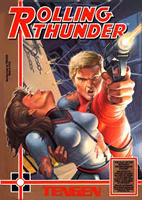 Rolling Thunder will always hold a special spot in my heart. When I was a kid my friend Derek and I had very few games for my NES, so we were always excited to play whatever we could find. It didn’t matter what it was, we played it. We bought games when we could find something for a few bucks or borrowed from whoever would lend them out. We got to play such excellent games as Dr. Jekyll and Mr. Hyde, NARC, Dance Aerobics, Skate or Die and others that didn’t hold our attention for long. The one diamond in the rough was Rolling Thunder. It didn’t come across as great game at first play, but as I started playing it more I realized just how addicting it would become. RT is a platforming run-‘n-gun game with lots of stealth elements based off of the arcade of the same name and released by Namco. Tengen did the port, which lost little in the translation, and at least for me turned out to be more enjoyable than the arcade original on which it was based.
Rolling Thunder will always hold a special spot in my heart. When I was a kid my friend Derek and I had very few games for my NES, so we were always excited to play whatever we could find. It didn’t matter what it was, we played it. We bought games when we could find something for a few bucks or borrowed from whoever would lend them out. We got to play such excellent games as Dr. Jekyll and Mr. Hyde, NARC, Dance Aerobics, Skate or Die and others that didn’t hold our attention for long. The one diamond in the rough was Rolling Thunder. It didn’t come across as great game at first play, but as I started playing it more I realized just how addicting it would become. RT is a platforming run-‘n-gun game with lots of stealth elements based off of the arcade of the same name and released by Namco. Tengen did the port, which lost little in the translation, and at least for me turned out to be more enjoyable than the arcade original on which it was based.
The game has you taking control of an agent out to rescue his female counterpart across ten of the most challenging stages found in a NES game. You start out with a basic hand gun that has a limited amount of ammo and fires rather slowly. Some of the stages have hidden machine guns that burn through their ammo faster but allow you to mow through crowds of enemies rather quickly. Stealth and well-planned movements are the name of this game, which is filled with enemies. You can only take two hits when bumping into an enemy and one hit from a bullet. As you play through each stage you’ll see many doors, walls, and other obstacles that you can use for cover. The doors can all be entered, and you can hide for as long as the timer permits. They are also how you find extra ammo or health. Staying in a door too long may cause a swarm of enemies to crowd it, making it impossible to get out alive, so timing and strategy is essential. You, as well as your enemies, can also take cover behind crates and hide inside stacks of tires or even in fences or cages to avoid fire, which adds a lot of variety to the gameplay. The controls are simple with B for firing and A doing a normal jump or a high jump to reach higher platforms by pressing up and A together.
As you progress through the game you have to start making more and more precise jumps, as well as fight mutated enemies, birds, and panthers which are really fast and hard to hit. Some of the stages’ themes start to repeat, and some are the same as a previously visited stage but with some new additions. By the time you make it through all ten stages you’ll feel like a video game god, since the game gets mindbogglingly difficult. It stays really addicting and never gets to the point where you want to throw your controller, due to a password option after every two stages you finish. I really can’t point out any really glaring flaws in the game at all. It can get a tad repetitive during a few of the stages, and maybe some will find the slower paced style of game play to not be their cup of tea, but are those really complaints?
On the other hand, the graphics and visuals all look really close to the arcade original. Yes, the arcade looks a tad sharper and is a lot brighter, but the NES really doesn’t lose anything in the translation, and I actually prefer the darker and slightly drabber appearance of the NES. Everything visually is easy on the eyes, and despite being simple in appearance, everything is pleasing to look at. All of the characters in the game have a lot of frames of animation and are look good despite being a bit too tall and lanky. The backgrounds are all pretty simple, but they all just work really well and set a nice mood to the game, and I really like that.
I’m just as happy with the music and sound effects as I am with the graphics. The NES replicates the arcade’s sound effects really well, but once again I like them a lot better on the NES, as any game using Namco’s System 86 arcade board seemed to have really harsh sounding audio. The music also fits the mood of the game really well, and many of the themes in the game are really well done. I never got tired of listening to them. I don’t know if they’re quite Ipod worthy, but in the game they just work really well. The sound effects are a tad generic sounding but also work and flow well with the game.
Along with the NES, Rolling Thunder was released on several of computer platforms of the day, and despite the wide release and mostly positive reviews it still seems to fly under the radar. Tengen did a really commendable job handling the port, and in my opinion it’s one of its best games on the NES. It would easily land on any of my top NES game lists mostly due to loving it so much as a kid. If you really like this game, then you’ll be happy to know that it spawned two Sega Genesis exclusive sequels which are even better than the original. Or if you played those but haven’t played the original, then you really should check it out when you get the chance, and it will only set you back a few bucks at most.
Rating (out of five): 




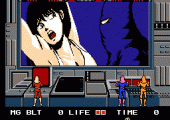
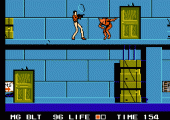
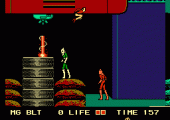
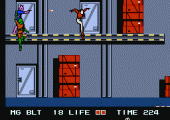
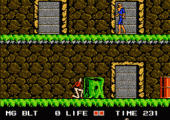
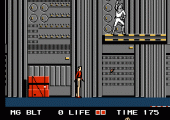
Why is there a NES review here…?
Hands-On articles examine sequels and titles that either originated or continued on the Genesis. Combined with the reviews and/or features on the Genesis games, it gives readers a much more complete perspective on the entire series.
Oh OK, makes sense. I don’t remember seeing that done before so I was thrown off hahahaha.
Nice review. I like the NES/FC port of Rolling Thunder quite a bit, especially the JP cart. The JP Famicom version is similar to the US version, but uses a special sound chip for better sound.
One thing. Tengen didn’t program the port, they only published it in the US. The port was actually programmed in Japan for Namco.